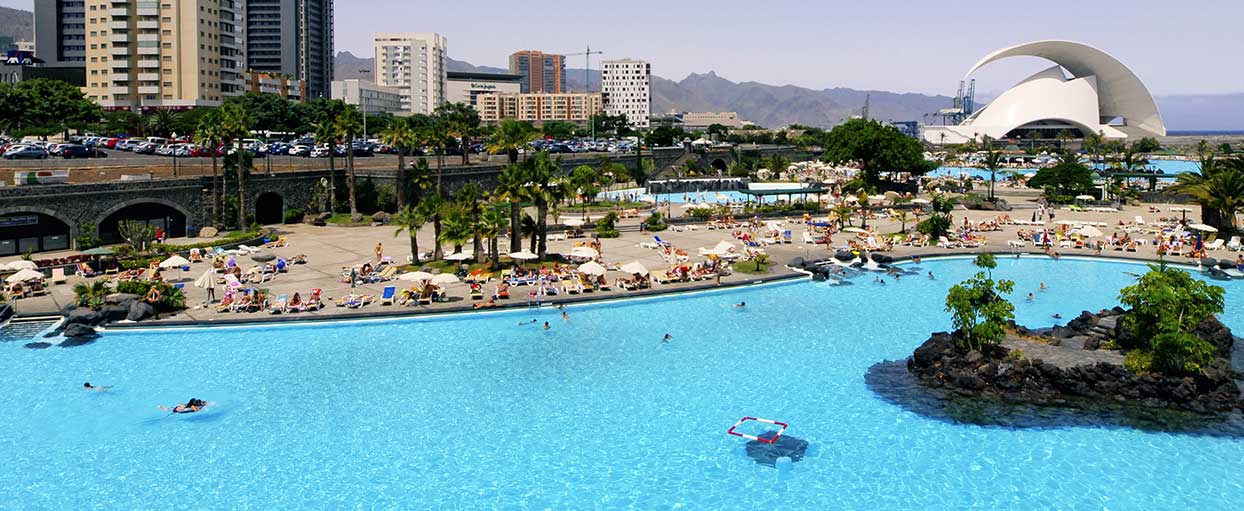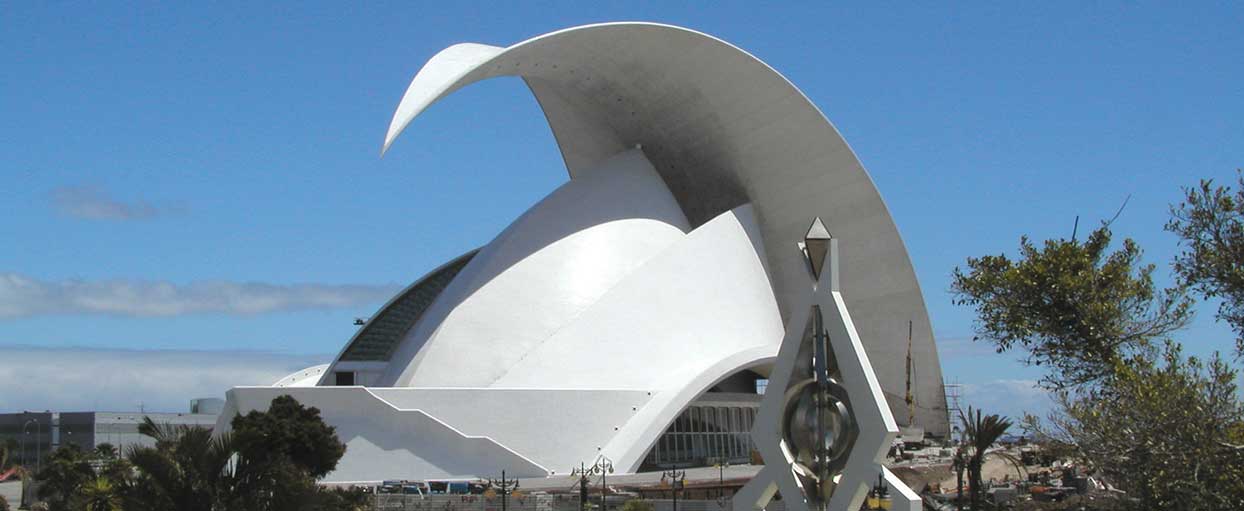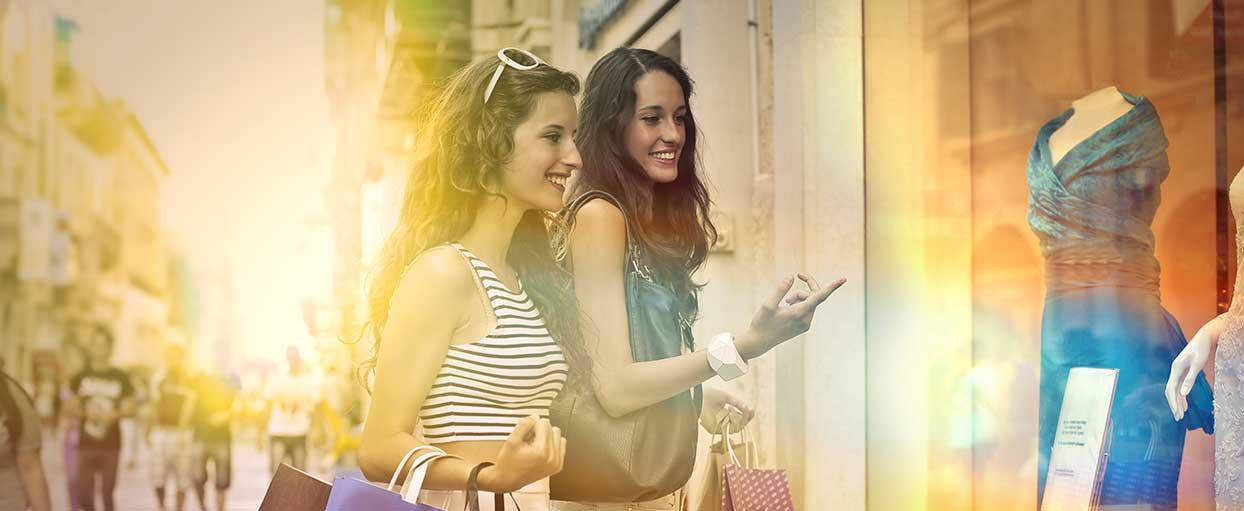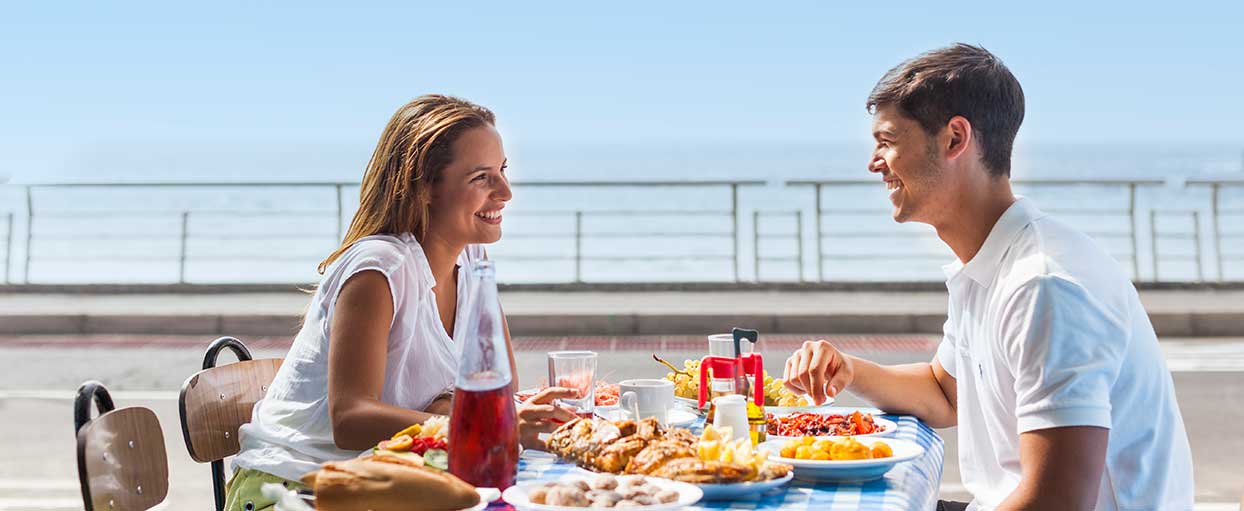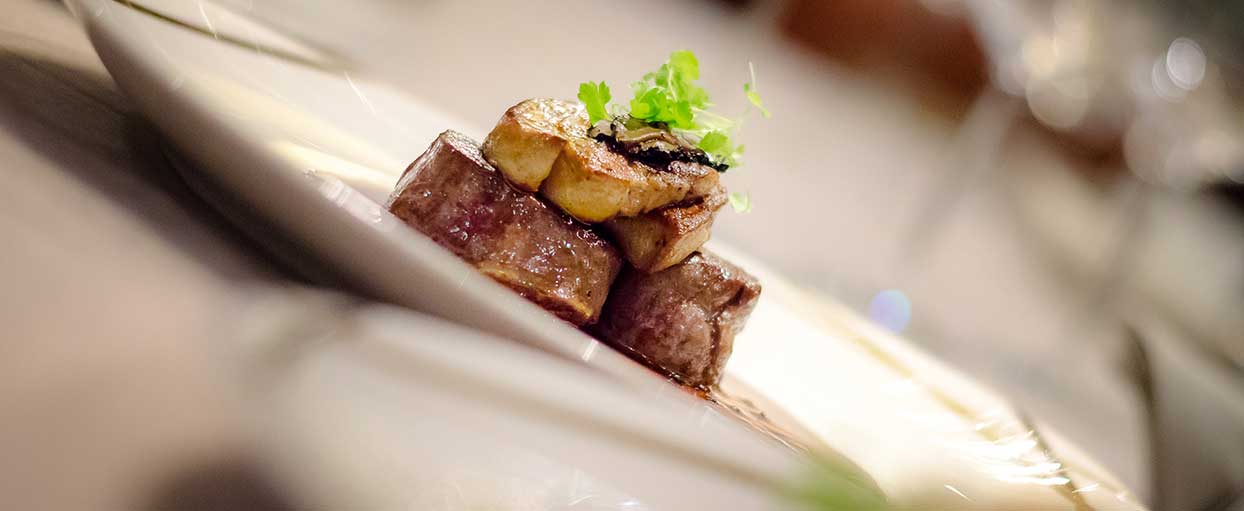The new area of expansion of the city, called Cabo-Llanos, started to be developed from 1992 onwards. It was formerly a small neighbourhood occupied by fishermen who were relocated to the periphery. It currently hosts the most important leisure and cultural venues on the island, Tenerife’s main administrative and judicial headquarters and several prominent shopping centres.
In this area it is possible to visit the following venues:
TENERIFE ADAM MARTÍN AUDITORIUM
Designed by the architect Santiago Calatrava, this is a building with a strong sculptural impact. Located on Avenida de La Constitución, in the neighbourhood of Cabo Llanos, it represents a gigantic white mosaic sailing boat or a majestic wave that has escaped from the adjacent sea.
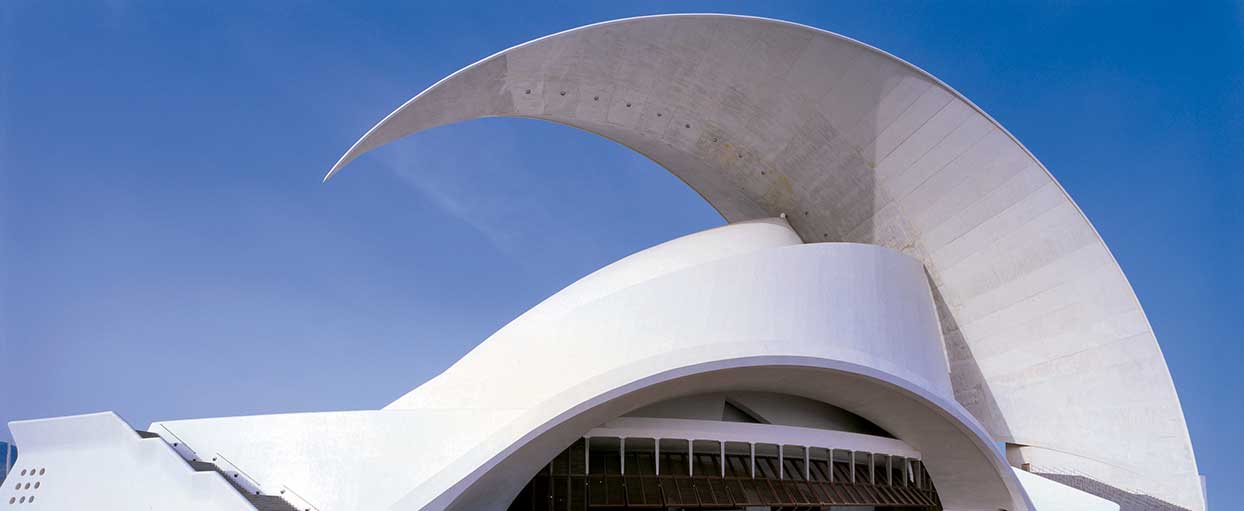
It has two rooms equipped for concerts, musicals and plays and amongst the many personalities who have visited it are the former US president, Bill Clinton, and the late scientist Stephen Hawking.
It is currently the home of the Symphony Orchestra of Tenerife.
SAN FRANCISCO BATTERY
Just in front of the Tenerife Adán Martín Auditorium is the San Francisco Battery, which was part of the city’s defensive system from the last third of the 18th century onwards, when Santa Cruz was considered a Fortress as it had a score of castles and batteries that, due to various circumstances, have since been lost.
A magnificent example of military architecture, it has great historical value as it was in service during the defence of the city against the attack of the English fleet commanded by Englishman Vice Admiral Horatio Nelson in 1797 and it is located in the coastal part of the city in a urban environment where there has been a great deal of development.
Excavations are currently being carried out to find out what exists beneath the layer of soil that covers it.
REGLA HERMITAGE
In the year 1643, after the construction of San Juan Castle, the Cabildo (council) considered it necessary to provide its garrison with an oratory or chapel nearby, because those places were a long way from the town centre. This was the origin of the current hermitage of Regla, originally dedicated to Our Lady of Guadalupe.
The image, of American origin, currently known as Nuestra Señora de Regla, was very popular with sailors and was possibly donated by the captain of the Indian route Domingo Díaz Virtudes, who in 1666 left a legacy of four thousand reals for the hermitage in his will. In the next century, its greatest benefactor was the merchant and shipping company Matías Rodríguez Carta, which expanded its chapel and sacristy whilst improving the materials and ornaments.
That fishermen’s neighbourhood showed great devotion to the Virgin of Regla, especially during its festival which was celebrated on 8th September, whose procession was greeted from 1666 onwards with salvos from the castle. However, its cult declined in the nineteenth century to the point that the hermitage experienced a number of misfortunes.
When the epidemic of yellow fever ravaged the city between 1810 and 1811, as there was no more space available at the churches for burials, this hermitage was used to bury those killed by the disease. Two children of the commander general Ramón de Carvajal were buried here along with other famous personalities, including Field Marshal José de Arriaga and many residents in narrow ditches, which made it necessary in the following years to suspend the festivities due to the combination of the heat and the large number of corpses under the ground.
The site was considered so inconvenient that a neighbouring lot was the place chosen to execute Ángel García “Cabeza de Perro” (Dog Head), a pirate famous for his cruelty. Shortly afterwards, due to a new epidemic, this time of diphtheria and measles, the bishop offered the area to the City Council as an isolation hospital and in 1898, due to the war in Cuba, it was used as a military depot. It was also used in the last century as a school for the Los Llanos neighbourhood. Later, in 1943, it became a parish church, an initiative that was not very successful.
The building has suffered an almost total adulteration, having lost its roof made of Arab tile and, among other details, the original gable of the façade, in the corner of the Epistle, which was replaced by another central one with disproportionate dimensions. Apart from serious signs of deterioration in the exterior walls, the surfaces of the surrounding paths have gained height whilst the hermitage has remained at a lower level, which causes serious problems whenever it rains heavily. The historical and social significance of this small temple is worthy of a profound renovation.
The old fishermen’s neighbourhood of Regla has long since disappeared amongst the new modern roads and buildings. However, the former neighbours and their descendants, who today live in other areas of the capital, still celebrate the festival of Our Lady of Regla every 8th September at the small hermitage.
CASTLE OF SAN JUAN BAUTISTA
Although it has been modified over the years, this is the only fort that remains intact of those that formed part of the defensive line of the fortress. Its construction, financed by the island’s Cabildo (council) with contributions made by the residents, began around 1641 and was completed in 1643 and, as it was not built at the expense of the Royal Treasury (as was the case with the main castle of San Cristóbal), King Charles I granted the privilege of being able to appoint its lords, contrary to what was customary for royal fortresses, a privilege confirmed by Charles II in 1684. There is evidence of repairs in 1685 and that renovations were carried out between 1765 and 1767. Its structure is made of basalt ashlar and it has a ditch fed with sea water and an access bridge.
In 1788, this enclave was armed with five 24-pound guns, two 16-pound and a 9-pound mortar and it was manned by 13 men including the commanders, which could be increased to about one hundred in wartime. This fort on the Southern flank of the line was the third largest belonging to the Navy of Santa Cruz, with the other two being San Cristóbal in the centre (now Plaza de España), which has now disappeared, and the one at Paso Alto, to the North of the port.
On the night of 24th to 25th July 1797, during the attack of the forces commanded by Horatio Nelson, this castle had almost no opportunity to intervene as only four cannon shots were fired for dissuasive purposes and without consequences when it was noticed that some of the English boats that had arrived at the mouth of the Santos ravine had drifted south, approaching its surroundings. Nevertheless, its garrison had been reinforced with 30 French soldiers from the corvette La Mutin (which was captured at the port two months before by the English) commanded by one of its officers.
The place where the fort is located was known from the earliest of times as Caleta de Negros, without there being any record of the reason for that name, although it is possible that this place name has contributed to the castle being also known as Castillo Negro. In 1924 it was declared unsuitable for use and in 1948 it was ceded to the Cabildo for the creation of a Military Museum, which was not successful in this location.
It is now municipal property and, although it has been maintained in good condition, it is not clear what it will be used for despite the many possibilities it offers.
CASA DE LA PÓLVORA (GUNPOWDER HOUSE)
Given the need to have a place to store gunpowder in the fortress, in 1756 work began on this warehouse, which was completed two years later. Gunpowder had previously been kept in a house belonging to the island council near the Regla hermitage, but there were complaints about the amount that was wasted on unjustified salvos: in 1706, when the bill was presented, the constable of the castle reported that in ten years 6,731 pounds had been spent on salvos, which the Cabildo ordered to be paid for by the last wardens. However, twenty years later, the commander-in-chief the Marquis of Valhermoso was accused by the Council, among other things, of having wasted gunpowder on salvos.
When the gunpowder store was just over thirty years old it was realized that it was located in a place of high-risk in the event of an attack from the sea and the gunpowder was taken to San Joaquín Castle, in La Cuesta, a place too far away from the coastal defences. Finally, around 1887, it was decided to move the gunpowder store to Taco, which was just as far away but the military circumstances and logistics had changed by then. The warehouse near San Juan Bautista Castle, which had been abandoned many years before, was ceded to the municipality in 1926.
The building, made using the country’s basaltic stonework with a cyclopean appearance, is an authentic relic and an example of this type of building for military use and it currently stands unoccupied in a privileged part of the current area of urban expansion, between San Juan Castle and the modern Maritime Park. It has been used sporadically as an exhibition hall and it would be a good location for art, historical cartography or handicraft exhibitions.
CÉSAR MANRIQUE MARITIME PARK
The Maritime Park is currently located on a stretch of coastline at the southern end of the city, which has historically been classified as a controversial area without any urban development where the only activities allowed were amateur inshore fishing and activities related to the location of the Lazaretto or isolation hospital. Later, the authorization of the installation of the Petroleum Refinery, which started operating in 1930 to provide fuel for the Canary Islands’ energy supply, made this area a neglected part of the capital for many years.
In order to find a solution to this problem an ambitious sanitation operation was planned and successfully achieved through the implantation of a recreational and leisure area, along with the botanical garden called the Palmetum.
This was therefore the origin of the Maritime Park, which opened its doors in 1995 and was the last and posthumous work of the famous Lanzarote artist César Manrique. Based on his original idea, the engineers José Luis Olcina and Juan Alfredo Amigó carried out this ambitious project of more than 22,000 m2 that today has become a symbol of the capital and part of the city’s landscape. Its integration into the fabric of the town, its proximity and it permanent contact with the sea make it an area of unique beauty that is both accessible and close.
For its design, natural elements such as volcanic rocks, palm trees and ornamental plants were used along with saltwater waterfalls. All of this was seasoned with the unmistakable wind toys designed by Manrique.
In addition to its 3 saltwater swimming pools it has restaurants, shops, changing rooms, playrooms, showers, a gym and hammock and umbrella rental services, making it an ideal place for tourism, family, leisure and rest activities.
It has a lake of 7,800 m2 surrounding an island, with gardens at different heights and three seawater pools, all decorated with natural elements such as volcanic rocks, palm trees and ornamental plants, along with various waterfalls.
Large terraces, solariums and swimming pools are distributed around elements of Santa Cruz’s history such as San Juan Castle, the Gunpowder House and the basaltic waterfall, all with an architectural style based on military austerity that simulates the aforementioned fortress with the use of dark stonework.
SANTA CRUZ EXHIBITION CENTRE
The International Trade Fair and Conference Centre of Tenerife, also known as the Exhibition Centre, is located on Avenida de la Constitución, which forms the new expansion area of the city, known as Cabo-Llanos, was developed from 1992 onwards.
Designed by the architect Santiago Calatrava, the Exhibition Centre was inaugurated in 1966. It has been designated an International Centre for Trade Fairs, Conferences and Exhibitions due to its large dimensions, modern infrastructure and facilities and it is used to host everything from concerts to boxing championships and exhibitions of all kinds.
During the Carnival, almost all of the contests and the Gala for the Election of the Queen of Santa Cruz de Tenerife are held here.
[/tabitem] [tabitem]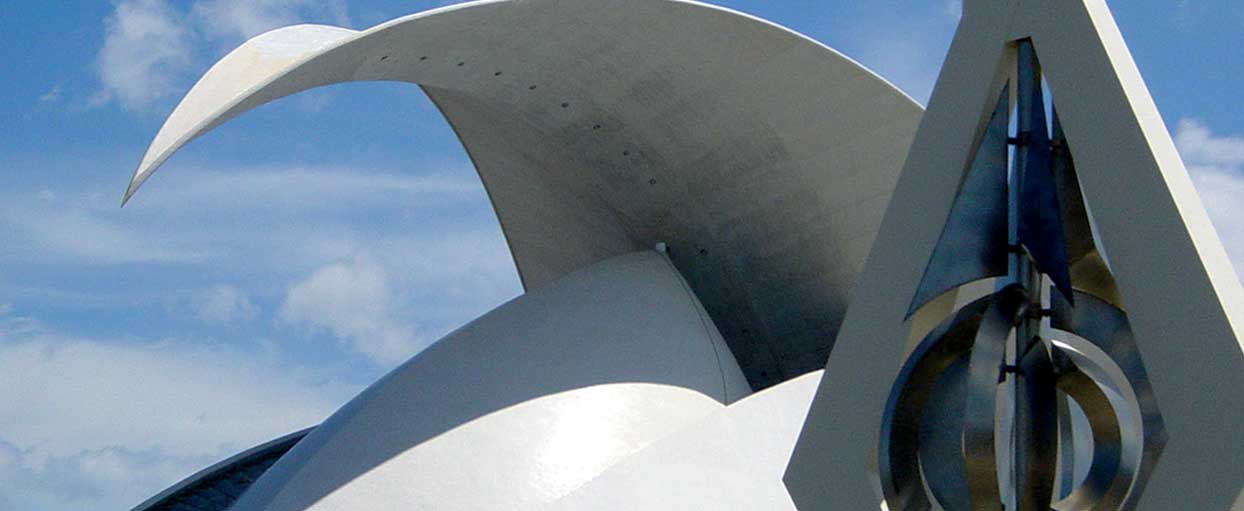
SHOPPING:
With an average temperature of 21 degrees all year round, Santa Cruz is the perfect place to shop in the most extensive open shopping area of the island. Small shops and big brands mingle in an outdoor setting where locals and visitors turn shopping into a unique experience. There is a great variety of shops, cafés, bars, and restaurants to spend a pleasant day browsing and relaxing. The city has the best boutiques and international brands with the latest fashion trends on display in their shop windows. Throughout the city’s shopping streets, large department stores and shopping malls coexist with traditional, small shops where a personal shopping experience and product quality are in the forefront. All of this is wrapped up in a pleasant, friendly atmosphere that makes you want to stroll along the city’s streets, parks, squares and gardens and to sit down to have a drink at any of its many bar terraces.
The shops’ and restaurants’ closeness to each other turns visiting Santa Cruz into a unique experience. The city is easy to access and equipped with enough parking and public transport services: trams, buses, and taxis.
We suggest you see the city by taking some of the following shopping routes:
Route 1 City Centre: Calle Pérez Galdós, calle Viera y Clavijo, calle Méndez Núñez, calle Pi y Margall, calle Suárez Guerra, calle El Pilar, shopping centre “Centro Comercial Parque Bulevar”, calle La Rosa and nearby streets. Enjoy this shopping experience in an area where you can find all kinds of stores offering clothing, accessories, footwear, jewellery, watches, perfumes… This route contains a great number of boutiques showcasing leading brands, with exquisite service and a wide range of unique designs.
Route 2 City Centre: Plaza de La Candelaria, calle Castillo, calle Imeldo Serís, calle Valentin Sanz, calle Bethencourt Alfonso and nearby streets. In the heart of the city you will find the street calle Castillo, a traditional shopping street with all kinds of international franchises and fashion retail chains. The route follows this street, which begins in Plaza de Candelaria and ends at Plaza Weyler.
Route Ramblas: Plaza Weyler, Rambla Pulido, Rambla de Santa Cruz and nearby streets. This route is characterized by a concentration of the commercial activity around both Ramblas: Rambla de Santa Cruz and Rambla de Pulido. There you will find a wide range of shops characterized by the kind service and the quality of products. Along the Rambla de Santa Cruz you can enjoy an exhibition of Sculptures in the Street, which makes the shopping experience much more enjoyable.
Route Shopping Centres: This route is characterized by the presence of large department stores and shopping malls around which one can find a wide array of smaller shops and restaurants to suit all tastes. The main streets are Avenidas Tres de Mayo and Manuel Hermoso Rojas, calle Álvaro Rodríguez López, calle Aurea Díaz Flores and Avenida La Salle. Along this route you can enjoy a wide variety of leisure opportunities inside the shopping centres (cinema, restaurants and personal services) as outdoors (Auditorio de Tenerife Adán Martín, Recinto Ferial de Tenerife, Parque Marítimo César Manrique and Palmetum).
Route Market “Nuestra Señora de Africa”: La Recova, Rambla Azul, shopping centre Recova and Rastro de Santa Cruz (only Sundays). The Market’s shopping area is one of the busiest commercial districts on Santa Cruz. Its central nucleus is the Market of Santa Cruz de Tenerife, or La Recova. It has been open since 1944 and is the successor of the Old La Recova, which goes back to the 19th century. Here you can find the freshest foods from the Canary Islands and from all over the whole world. It specializes in fruit and vegetables, meats and fish, although you can purchase all sorts of foods there, as well as typical products.
The Neo-Colonial building that houses La Recova, is arranged over two large floors, with open patios where you can take a pleasant stroll and enjoy admiring the great variety of fresh foods for sale. Inside you will find a Café with terrace, a place to rest and enjoy food and all types of drinks. Opening hours of the Market Nuestra Señora de Africa are Monday to Saturday from 06 a.m. to 2:00 p.m., and Sundays from 7:00 a.m. to 2:00 p.m.
Next to the market you will find La Rambla Azul, its opening hours are from Monday to Sunday 9 a.m. to 2 p.m. There is also the Shopping Center with more than 40 shops and cafeterias, it opens from Monday to Saturday 9 a.m. to 9 p.m. and Sundays from 9 a.m. to 3 p.m.
Sundays morning are the days that the ‘Rastro,’ the large street market of Santa Cruz, is held at Avenida José Manuel Guimerá, surroundings of the open market Recova and Calle Bravo Murillo. Here you can find a great variety of first and second hand articles, antiques, clothes and fashion accessories in a festive and friendly environment.
GASTRONOMY:
Santa Cruz is the heart of Tenerife and as such it is the home of a range of food and drinks. All parts of the world are represented in the municipality. It’s a place where the food sector has experienced a remarkable growth in the last few years and the zone is known for being a metropolitan area that is home to two stars from the prestigious Michelin Guide.
The gastronomy is undoubtedly part of the local character of a culture. In this sense, the Canary Islands can proudly say that their cuisine is both simple and original in nature and that this is true in terms of the choice of ingredients and how dishes are prepared, with the Islands’ cuisine being based on the Guanche heritage, but also having a clear Spanish influence.
However, despite its simplicity, traditional Canarian cuisine is authentic and rich in flavours that give it a personality of its own – a personality that has been influenced by the Island Chain’s climate and the use of the products readily available in its sea and on its land.
Among the ingredients of traditional Canarian cuisine, some of the most important are products from the sea, such as fish and shellfish like the “vieja” (Mediterranean parrotfish), a white fish with a mild flavour, the “choco” (cuttlefish), a type of squid with a larger size, and the “cherne” (wreckfish), a fish that is consumed salted or as a stew.
In terms of foods from the land, the sweet potato and the potato are the indisputable companions to meat and fish, with the potato being famous in its “papas arrugadas” form (“Canarian wrinkly potatoes” – boiled potatoes with their skins left on). Vegetables such as the tomato, onion, garlic, varieties of peppers, squash, zucchini (or “bubango”), watercress, coriander, and parsley can be used in soups, stews, and in the preparation of the famous Canarian “mojo” sauce in its two versions: green (containing coriander) and red (“mojo picón,” containing pepper).
In terms of meats, noteworthy are dishes based on pork, rabbit, and kid goat, all of which can be prepared with a sauce as a stew, fried, or roasted.
Goat’s milk is the basic ingredient of the cheeses from the Canary Islands, which are consumed fresh, semi-cured, cured, and even smoked.
But there is a Canarian food product that is derived from grains like corn, wheat, and barley and which has become established as a “symbol” of the gastronomic culture of the islands. It is known as “Gofio” (a fine mixture of the aforementioned grains previously toasted and ground) and it has multiple culinary applications, as it has acted as the “bread of the canaries” (kneaded with water and not cooked), it can be consumed “scrambled” with broth (escaldón) or a stew, and it can even be mixed with honey and almonds to act as a desert. Its consumption is so widespread that, in many homes, it is customary to mix gofio with milk and sugar and use it for breakfast. Other products that complement the cuisine of the Canary Islands are the local wines from the region, with Tenerife being the perfect example. The island is divided into five wine-producing districts, and Santa Cruz de Tenerife is located in the Tacoronte-Acentejo district. Tenerife’s gastronomy brings together the products and dishes that are most representative of Canarian cuisine with a wide range of dining establishments.
One of the increasingly popular trends over the past few years is the diversification of traditional cuisine, giving rise to a new, more creative and contemporary branch of cooking known as “signature cooking.” While this type of cuisine keeps its base through the use of traditional products, it innovates by introducing new and exotic ingredients (many of them foreign) and a mix of flavours that bring originality to the recipe. Likewise, emphasis is placed on the dishes’ presentation, turning them into artistic creations done by expert chefs.
The dining sector of the municipality of Santa Cruz de Tenerife has it all. Visitors can find the best of the traditional cuisine mostly in restaurants or “guachinches” around the Anaga area. In the rest of the city, there are establishments that offer everything from traditional Canarian cuisine to exquisite “signature cooking” and more creative dishes, without forgetting the wide range of regional Spanish specialties, bars serving “tapas,” and a great variety of restaurants that offer international cuisine.
[/tabitem][/cq_vc_tabs]

